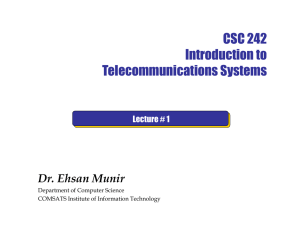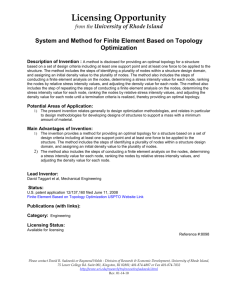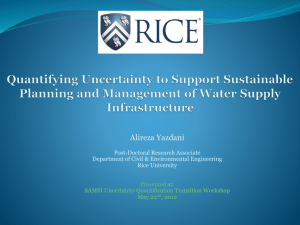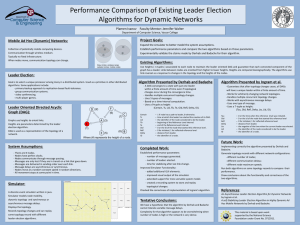Classification of network topologies
advertisement
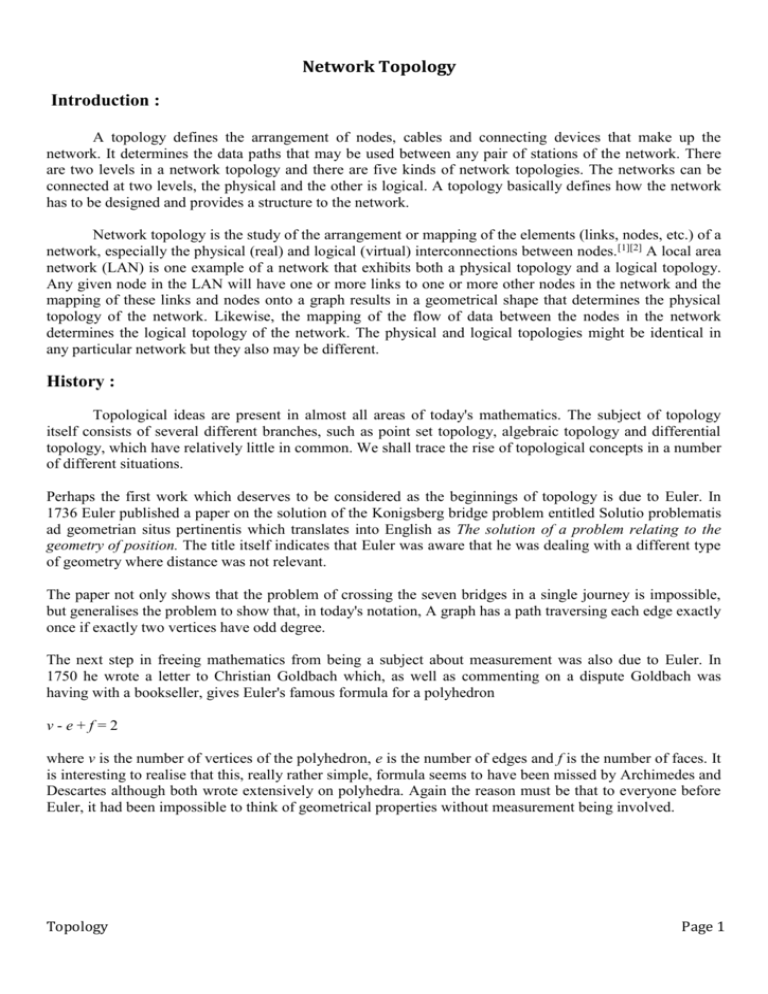
Network Topology Introduction : A topology defines the arrangement of nodes, cables and connecting devices that make up the network. It determines the data paths that may be used between any pair of stations of the network. There are two levels in a network topology and there are five kinds of network topologies. The networks can be connected at two levels, the physical and the other is logical. A topology basically defines how the network has to be designed and provides a structure to the network. Network topology is the study of the arrangement or mapping of the elements (links, nodes, etc.) of a network, especially the physical (real) and logical (virtual) interconnections between nodes. [1][2] A local area network (LAN) is one example of a network that exhibits both a physical topology and a logical topology. Any given node in the LAN will have one or more links to one or more other nodes in the network and the mapping of these links and nodes onto a graph results in a geometrical shape that determines the physical topology of the network. Likewise, the mapping of the flow of data between the nodes in the network determines the logical topology of the network. The physical and logical topologies might be identical in any particular network but they also may be different. History : Topological ideas are present in almost all areas of today's mathematics. The subject of topology itself consists of several different branches, such as point set topology, algebraic topology and differential topology, which have relatively little in common. We shall trace the rise of topological concepts in a number of different situations. Perhaps the first work which deserves to be considered as the beginnings of topology is due to Euler. In 1736 Euler published a paper on the solution of the Konigsberg bridge problem entitled Solutio problematis ad geometrian situs pertinentis which translates into English as The solution of a problem relating to the geometry of position. The title itself indicates that Euler was aware that he was dealing with a different type of geometry where distance was not relevant. The paper not only shows that the problem of crossing the seven bridges in a single journey is impossible, but generalises the problem to show that, in today's notation, A graph has a path traversing each edge exactly once if exactly two vertices have odd degree. The next step in freeing mathematics from being a subject about measurement was also due to Euler. In 1750 he wrote a letter to Christian Goldbach which, as well as commenting on a dispute Goldbach was having with a bookseller, gives Euler's famous formula for a polyhedron v-e+f=2 where v is the number of vertices of the polyhedron, e is the number of edges and f is the number of faces. It is interesting to realise that this, really rather simple, formula seems to have been missed by Archimedes and Descartes although both wrote extensively on polyhedra. Again the reason must be that to everyone before Euler, it had been impossible to think of geometrical properties without measurement being involved. Topology Page 1 Types of topologies : The arrangement or mapping of the elements of a network gives rise to certain basic topologies which may then be combined to form more complex topologies (hybrid topologies). The most common of these basic types of topologies are (refer to the illustration at the top right of this page): O O O O O O O Bus Star Ring Mesh Tree Hybrid Point to Point Classification of network topologies: There are also three basic categories of network topologies: 1. Physical topologies 2. Signal topologies 3. Logical topologies The terms signal topology and logical topology are often used interchangeably even though there is a subtle difference between the two and the distinction is not often made between the two. 1) Physical topologies: The mapping of the nodes of a network and the physical connections between them i.e. the layout of wiring, cables, locations of nodes and the interconnections between the nodes and the cabling or wiring system. Physical topologies can be further classified into : O Point-to-point O Bus O Star O Ring O Mesh O Tree Point-to-point The simplest topology is a permanent link between two endpoints. Switched point-to-point topologies are the basic model of conventional telephony. The value of a permanent point-to-point network is the value of guaranteed, or nearly so, communications between the two endpoints. The value of an ondemand point-to-point connection is proportional to the number of potential pairs of subscribers, and has been expressed as Metcalfe's Law. A. Permanent (dedicated) Easiest to understand, of the variations of point-to-point topology, is a point-to-point communications channel that appears, to the user, to be permanently associated with the two endpoints. Children's "tin-can telephone" is one example, with a microphone to a single public address speaker is another. These are examples of physical dedicated channels. Topology Page 2 B. Switched Using circuit-switching or packet-switching technologies, a point-to-point circuit can be set up dynamically, and dropped when no longer needed. This is the basic mode of conventional telephony. Fig: Point to Point (switched) topology Bus Topology : In bus topology, each computer is connected to a single communication cable via the interface. In bus topology, it is possible for every computer to communicate with every other computer in the network. Most bus networks broadcast signals in both the directions, so it enables for all devices to receive the signal directly. However, some buses are unidirectional when signals travel only in one direction. Bus topology can be further divide into two categories : A. Linear bus The type of network topology in which all of the nodes of the network are connected to a common transmission medium which has exactly two endpoints (this is the 'bus', which is also commonly referred to as the backbone, or trunk) – all data that is transmitted between nodes in the network is transmitted over this common transmission medium and is able to be received by all nodes in the network virtually simultaneously (disregarding propagation delays). B. Distributed bus The type of network topology in which all of the nodes of the network are connected to a common transmission medium which has more than two endpoints that are created by adding branches to the main section of the transmission medium – the physical distributed bus topology functions in exactly the same fashion as the physical linear bus topology (i.e., all nodes share a common transmission medium). Fig: Bus topology Topology Page 3 Advantages of Bus topology: 1. Short cable length : In bus topology, a single bus data path connects to all the nodes. So it requires a very short cable length to connect all the nodes. 2. Easy Architecture : The bus architecture is very simple. It contains a single cable through which all data passes and to which all the nodes are connected. 3. Easy to extend : It is possible to connect additional nodes easily in bus network. Disadvantages of bus topology: 1. Difficult to diagnose a fault : In bus topology, all the terminals are connected to the common bus. Also the control of the network is not centralized in any particular node. So it requires to detect a fault from many points in the network. 2. Fault isolation is difficult : If the fault occurs in the network itself, then entire segment of the bus must be disconnected. Star Topology : The type of network topology in which each of the nodes of the network is connected to a central node with a point-to-point link in a 'hub' and 'spoke' fashion, the central node being the 'hub' and the nodes that are attached to the central node being the 'spokes' (e.g., a collection of point-to-point links from the peripheral nodes that converge at a central node) – all data that is transmitted between nodes in the network is transmitted to this central node, which is usually some type of device that then retransmits the data to some or all of the other nodes in the network, although the central node may also be a simple common connection point (such as a 'punch-down' block) without any active device to repeat the signals. Fig: Star topology Star topology can be further divided into following categories : 1. Extended star A type of network topology in which a network that is based upon the physical star topology has one or more repeaters between the central node (the 'hub' of the star) and the peripheral or 'spoke' nodes, the repeaters being used to extend the maximum transmission distance of the point-to-point links between the central node and the peripheral nodes beyond that which is supported by the transmitter power of the central Topology Page 4 node or beyond that which is supported by the standard upon which the physical layer of the physical star network is based. 2. Distributed Star A type of network topology that is composed of individual networks that are based upon the physical star topology connected together in a linear fashion – i.e., 'daisy-chained' – with no central or top level connection point (e.g., two or more 'stacked' hubs, along with their associated star connected nodes or 'spokes'). Advantages of Star Topology: 1. Ease of service : Star topology has number of concentration points which are either at the central node or at the intermediate node. This provides easy access for service of reconfiguration of the network. 2. One device per connection : In the star topology, since all nodes are connected separately to the server or hub, so if connection between a particular node and server fails, it will not affect the functionality of other part of network. 3. Centralized Control : The central node (hub) is directly connected to other nodes in the network so all the power is exercised by the hub. 4. Simple Access Protocols : Star Network Involves only the central node & one peripheral node. So connection problem regarding the control of the medium for transmission purpose is easily solved. Disadvantages of Star topology: 1. Long cable length : In star topology, each node is directly connected to the server or central computer. So it requires a large quantity of cable. 2. Difficult to expand : The addition of new node requires a connection to the central node. Problem can arise as a longer cable is needed. 3. Central node dependency : If the central node in a star network fails, the entire network will collapse. Ring Topology : The type of network topology in which each of the nodes of the network is connected to two other nodes in the network and with the first and last nodes being connected to each other, forming a ring – all data that is transmitted between nodes in the network travels from one node to the next node in a circular manner and the data generally flows in a single direction only. Topology Page 5 Fig: Ring Topology The type of network topology in which each of the nodes of the network is connected to two other nodes in the network, with two connections to each of these nodes, and with the first and last nodes being connected to each other with two connections, forming a double ring – the data flows in opposite directions around the two rings, although, generally, only one of the rings carries data during normal operation, and the two rings are independent unless there is a failure or break in one of the rings, at which time the two rings are joined (by the stations on either side of the fault) to enable the flow of data to continue using a segment of the second ring to bypass the fault in the primary ring. Advantages of Ring Topology: 1. Short cable length : In ring topology, nodes are connected in a circular ring. Hence amount for cabling required is less. 2. No wiring closet space is required : In ring topology, only onecable is connecting each node to its immediate neighbors. So it does not require to allocate space for wiring closets. 3. Suitable for optical fibers : In ring topology, traffic travels in one direction. So it is easy to use optical fiber as a medium of transmission. Disadvantages of Ring Topology: 1. Node failure causes network failure : In ring topology, the data travels through all connected nodes in the ring and then it will reach a required node. If one node fails to pass data through itself, then entire network will fail. 2. Difficult to diagnose fault : Failure of one node will affect the entire network. To find a faulty node, it requires to examine a series of adjacent nodes. 3. Network reconfiguration is difficult : In ring topology, to add a new node or to delete a node in a network is difficult job. Also it is difficult to remove a particular node from the existing network. Mesh Topology : Mesh Network is a network where all the nodes are connected to each other and is a complete network. In a Mesh Network every node is connected to other nodes on the network through hops. Some are connected through single hops and some may be connected with more than one hope.While the data is traveling on the Mesh Network it is automatically configured to reach the destination by taking the shortest route which means the least number of hops. Data travels by hopping from one node to another and then Topology Page 6 reaches the destination node in a Mesh Topology Network. Mesh topology can be divided into further categories O Fully connected The type of network topology in which each of the nodes of the network is connected to each of the other nodes in the network with a point-to-point link – this makes it possible for data to be simultaneously transmitted from any single node to all of the other nodes. The physical fully connected mesh topology is generally too costly and complex for practical networks, although the topology is used when there are only a small number of nodes to be interconnected. O Partially connected The type of network topology in which some of the nodes of the network are connected to more than one other node in the network with a point-to-point link – this makes it possible to take advantage of some of the redundancy that is provided by a physical fully connected mesh topology without the expense and complexity required for a connection between every node in the network. Fig : Partially connected mesh topology Advantages of mesh topology : O O O O No traffic problem as there are dedicated links. Robust as failure of one link does not affect the entire system. Security as data travels along a dedicated line. Points to point links make fault identification easy. Disadvantages of mesh topology : Topology Page 7 O The hardware is expansive as there is dedicated link for any two nodes and each device should have (n-1) I/O ports. O There is mesh of wiring which can be difficult to manage. O Installation is complex as each node is connected to every node. Tree Topology : The type of network topology in which a central 'root' node (the top level of the hierarchy) is connected to one or more other nodes that are one level lower in the hierarchy (i.e., the second level) with a point-to-point link between each of the second level nodes and the top level central 'root' node, while each of the second level nodes that are connected to the top level central 'root' node will also have one or more other nodes that are one level lower in the hierarchy (i.e., the third level) connected to it, also with a point-to-point link, the top level central 'root' node being the only node that has no other node above it in the hierarchy (The hierarchy of the tree is symmetrical.) Fig : Tree topology Advantages of a Tree Topology: O Point-to-point wiring for individual segments. O Supported by several hardware and software venders. Disadvantages of a Tree Topology: O Overall length of each segment is limited by the type of cabling used. O if the backbone line breaks, the entire segment goes down. O More difficult to configure and wire than other topologies. 2) Signal topology : The mapping of the actual connections between the nodes of a network, as evidenced by the path that the signals take when propagating between the nodes. The term 'signal topology' is often used synonymously with the term 'logical topology', however, some confusion may result from this practice in certain situations since, by definition, the term 'logical topology' refers to the apparent path that the data takes between nodes in a network while the term 'signal topology' generally refers to the actual path that the signals (e.g., optical, electrical, electromagnetic, etc.) take when propagating between nodes. Example: In an 802.4 Token Bus network, the physical topology may be a physical bus, a physical star, or a hybrid physical topology, while the signal topology is a bus (i.e., the electrical signal propagates to all nodes simultaneously [ignoring propagation delays and network latency] ), and the logical topology is a ring (i.e., the data flows from one node to the next in a circular manner according to the protocol). Topology Page 8 3) Logical topology: The mapping of the apparent connections between the nodes of a network, as evidenced by the path that data appears to take when traveling between the nodes. Classification of logical topologies The logical classification of network topologies generally follows the same classifications as those in the physical classifications of network topologies, the path that the data takes between nodes being used to determine the topology as opposed to the actual physical connections being used to determine the topology. O Daisy chains : Except for star-based networks, the easiest way to add more computers into a network is by daisychaining, or connecting each computer in series to the next. If a message is intended for a computer partway down the line, each system bounces it along in sequence until it reaches the destination. A daisy-chained network can take two basic forms: linear and ring. A linear topology puts a two-way link between one computer and the next. However, this was expensive in the early days of computing, since each computer (except for the ones at each end) required two receivers and two transmitters. By connecting the computers at each end, a ring topology can be formed. An advantage of the ring is that the number of transmitters and receivers can be cut in half, since a message will eventually loop all of the way around. When a node sends a message, the message is processed by each computer in the ring. If a computer is not the destination node, it will pass the message to the next node, until the message arrives at its destination. If the message is not accepted by any node on the network, it will travel around the entire ring and return to the sender. This potentially results in a doubling of travel time for data, but since it is traveling at a fairly significant fraction of the speed of light, the loss is usually negligible. O Centralization: The star topology reduces the probability of a network failure by connecting all of the peripheral nodes (computers, etc.) to a central node. When the physical star topology is applied to a logical bus network such as Ethernet, this central node (traditionally a hub) rebroadcasts all transmissions received from any peripheral node to all peripheral nodes on the network, sometimes including the originating node. All peripheral nodes may thus communicate with all others by transmitting to, and receiving from, the central node only. The failure of a transmission line linking any peripheral node to the central node will result in the isolation of that peripheral node from all others, but the remaining peripheral nodes will be unaffected. However, the disadvantage is that the failure of the central node will cause the failure of all of the peripheral nodes also. A tree topology (a.k.a. hierarchical topology) can be viewed as a collection of star networks arranged in a hierarchy. This tree has individual peripheral nodes (e.g. leaves) which are required to transmit to and receive from one other node only and are not required to act as repeaters or regenerators. Unlike the star network, the functionality of the central node may be distributed. Topology Page 9 As in the conventional star network, individual nodes may thus still be isolated from the network by a single-point failure of a transmission path to the node. If a link connecting a leaf fails, that leaf is isolated; if a connection to a non-leaf node fails, an entire section of the network becomes isolated from the rest. O Decentralization : In a mesh topology (i.e., a partially connected mesh topology), there are at least two nodes with two or more paths between them to provide redundant paths to be used in case the link providing one of the paths fails. This decentralization is often used to advantage to compensate for the single-point-failure disadvantage that is present when using a single device as a central node (e.g., in star and tree networks). A special kind of mesh, limiting the number of hops between two nodes, is a hypercube. The number of arbitrary forks in mesh networks makes them more difficult to design and implement, but their decentralized nature makes them very useful. This is similar in some ways to a grid network, where a linear or ring topology is used to connect systems in multiple directions. A multi-dimensional ring has a toroidal topology, for instance. O Hybrids: Hybrid networks use a combination of any two or more topologies in such a way that the resulting network does not exhibit one of the standard topologies (e.g., bus, star, ring, etc.). For example, a tree network connected to a tree network is still a tree network, but two star networks connected together exhibit a hybrid network topology. A hybrid topology is always produced when two different basic network topologies are connected. Two common examples for Hybrid network are: star ring network and star bus network A Star ring network consists of two or more star topologies connected using a multistation access unit (MAU) as a centralized hub. A Star Bus network consists of two or more star topologies connected using a bus trunk (the bus trunk serves as the network's backbone). While grid networks have found popularity in high-performance computing applications, some systems have used genetic algorithms to design custom networks that have the fewest possible hops in between different nodes. Some of the resulting layouts are nearly incomprehensible, although they function quite well. Topology Page 10
